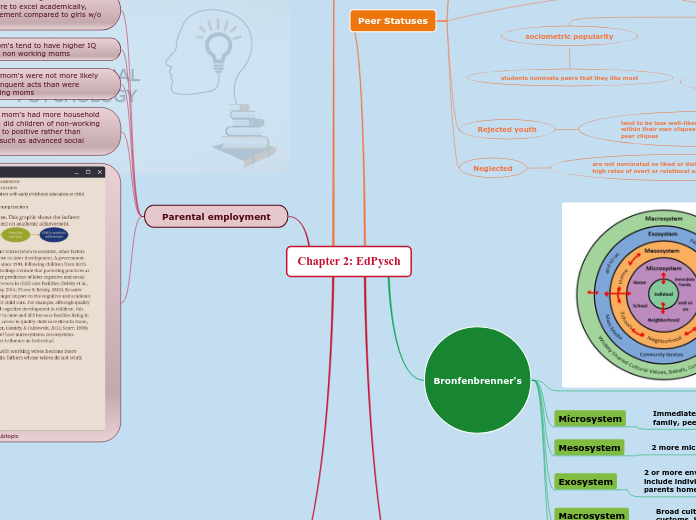Chapter 2: EdPysch
Peer Statuses
Overt Aggression
fighting with intent to harm another phsyically
Relational Aggression
behaviors specifically intended to damage another child's friendships, social status, or feelings of inclusion in a peer group
cyberbullying
intentional acts of relational aggression using electronic forms such as texting and social media
Popular
sociometric popularity
students nominate peers that they like most
perceived popularity
students nominate peers who are most popular or "cool" & those who are the least popular or "cool"
Rejected youth
tend to be less well-liked by peers including those within their own cliques and are members of smaller peer cliques
Neglected
are not nominated as liked or disliked and do not show high rates of overt or relational aggression
Bronfenbrenner's
Microsystem
Immediate environment of person such as family, peers, school
Mesosystem
2 more microsystem
Exosystem
2 or more environments 1 does not directly include individual such as parents work and parents home
Macrosystem
Broad cultural patterns such as beliefs, customs, knowledge, morals
Chronosystem
chronological nature of development with individual & history of area
50% of all 1st marriage end in divorce & 60% or more of 2nd in divorce
Changes in functions of family rather than structural changes
1. Family conflict
2. Disorganized parenting practices
3. Decrease in family economics (less $$$)
Kids that struggle the most
1. Younger kids
2. boys more than girls
3. kids placed in custody of opposite sex
4. kids w/ difficult temperament or have always struggled with change
5. kids who do not have supportive relationship w/ an adult outside home
Sleeper effect: children whose parents have been divorced for years may encounter problems in adolescence.
Self fulfilling prophecy
an unfounded expectation that becomes true simply because it was expected
Peer Context
Cliques
Small groups of 2-8 people who know each other well
similar # of demographics
age
race
ses
activies
values
Crowds
Larger groups based on reputations of peer groups w/ common labels
1. Populars/Preps(elites)
2. Jocks
3. Brains/nerds
4. Normal's (others)
5. Druggies/parties/burnouts
6. Loners
Parental employment
Girls w/ working mom's have higher achievement goals or greater desire to excel academically, higher school achievement compared to girls w/o working moms
girls w/ working mom's tend to have higher IQ scores compared to non working moms
Children w/ working mom's were not more likely to be involved in delinquent acts than were children of non-working moms
Children of working mom's had more household responsibilities than did children of non-working mothers, that leads to positive rather than negative outcomes such as advanced social development
Subtopic
Baumrind
Control
Responsiveness
Parenting styles
Authoritative
limits & rules & enforce & high emotional connectedness
Authoritarian
high level of control w/ no emotional connections
Permissive
less control no set rules w/ close emotional connection
Uninvolved
no rules & no emotional connection
